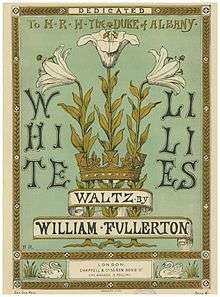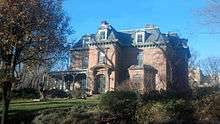William Fullerton (lawyer)
.jpg)
.jpg)
William S. Fullerton (May 1, 1817 – March 8, 1900), was a prominent New York lawyer of the Robber Baron era.
Life and career
Fullerton was one of twelve children born to a farming family in Minisink, New York.[1] He taught school while attending Union College (non-graduate, class of 1837), studied law with William C. Hasbrouck, and was admitted to the bar. He practiced in Newburgh, and served as District Attorney of Orange County, New York. After appearing in the same court case as Charles O'Conor, widely regarded as the dean of the New York bar, O'Conor invited Fullerton to join his partnership in New York City.[2] When O'Conor served as United States Attorney for the Southern District of New York in 1853 and 1854, he employed Fullerton as an Assistant U.S. Attorney to prosecute criminal trials.
In August 1867 he was appointed to fill a vacancy on the New York Supreme Court, and he served until the successor elected in November took office.
The growth of railroads and new industries brought an explosion of litigation, and commensurate opportunities for attorneys.[3] The Erie War of 1868-69, for example, pitted Cornelius Vanderbilt and his legal team (including Fullerton) against Jay Gould and confederates, with motions, hearings and injunctions keeping both sides busy nearly around the clock.[4]
Prominent cases in the 1870s made Fullerton a minor national celebrity. First, as a member of the defense team in the 1873 trials of "Boss" Tweed, his involvement in an effort to persuade Judge Noah Davis to recuse himself on grounds of prejudice led to Fullerton and others being censured and fined, despite Fullerton’s presentation at a hearing the New York Times would call “[one] of the most impressive proceedings ever witnessed in this city.”[5]
His reputation as the “Great American Cross-Examiner” would be established by his four days of cross-examining the orator and religious figure Henry Ward Beecher, in connection with Beecher’s 1875 adultery scandal trial.[6] Historians consider this trial a watershed event in the history of U.S. mass media, and the verbal jousting between Fullerton and Beecher was covered from coast to coast.[7]
In 1876, Fullerton teamed up with his brother, Judge Stephen W. Fullerton, in a sensational divorce case involving Robert H. Berdell, a former President of the Erie Railroad and a leading citizen of Goshen, New York. The lurid accusations as well as Berdell's business history brought national attention to the case. Although the Fullerton brothers were successful on Mrs. Berdell's behalf, the trial was followed a few months later by a violent altercation in which Berdell shot and killed Wisner Murray, his former brother-in-law, who was also the Village President of Goshen. A host of associated litigation continued for nearly 20 years. [8]
His career spanned more than 50 years, and encompassed a stunning array of high profile cases. In 1885, he represented the mysterious Englishwoman Lucille "Yseult" Dudley, who had tried to shoot Irish nationalist O'Donovan Rossa. Jeremiah O'Donovan Rossa [9]
Fullerton's only son, William Fullerton, Jr. (1854-1888), was a noted composer, who spent most of his adult years abroad. He studied composition in Leipzig and then settled in London, where his works were well received by the public.

His light opera "The Lady of the Locket" had a strong run at London's Empire Theatre, but his premature death at age 34 put an end to a promising career.

Today, Fullerton is commemorated at The Fullerton Mansion, which he built in Newburgh as a second home in 1868. He retired to it in the 1880s and lived there until his death on March 8, 1900. It is currently owned privately,[10] but available for community activities under the auspices of the Fullerton Cultural Center.
Fullerton is buried alongside his wife Cornelia (Gale) at Saint George's Cemetery in Newburgh.[11]
References
- ↑ The Fullerton Family, Hon. Walter C. Anthony, Reprinted from the Historical Papers No. XIII of the Historical Society of Newburgh Bay and the Hudson Highlands, 1906
- ↑ New York Times, March 16, 1900, “Death List of a Day, Ex-Judge William Fullerton"
- ↑ "Railroaded, The Transnationals and the Making of Modern America", Richard White, W.W. Norton, NY, 2011
- ↑ "Chapters of Erie and Other Essays", Charles Francis Adams, Jr. and Henry Adams, James Osgood, Boston, 1871 (reprinted NY August M. Kelley, 1967)
- ↑ New York Times, November 30, 1873, “Contempt of Court”
- ↑ "The Art of Cross-Examination," Francis H. Wellman, Ch. XI, ‘Some Famous Cross-Examiners and Their Methods,' MacMillan Company, NY 1903
- ↑ "The Most Famous Man in America," Debbie Applegate, Three Leaves Press, Doubleday, NY, 2006
- ↑ "Divorce Goshen Style", Orange County Historical Society Journal, Vol. 44, November 1, 2015, pp. 2-9
- ↑ Green, Michael, "A Pistol Shot from across the Ocean", New York Archives, Vol. 15, No. 4, Spring 2016.
- ↑ Jennifer Farley, the Chronogram, published 01/01/2013, accessed 11/28/2013, "Buying Stock in Newburgh: the Fullerton Mansion"
- ↑ "History comes to life in 2 cemeteries". Times Community Newspapers of the Hudson Valley. September 17, 2009.
External links
William Fullerton at Find a Grave